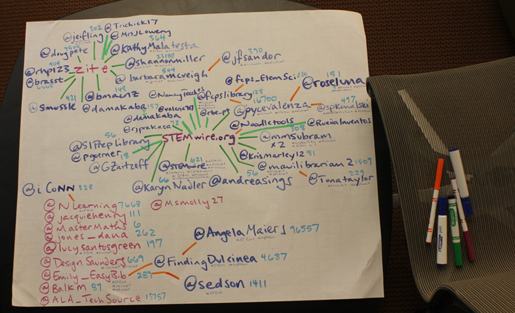It’s no secret at Reese News Lab that I’m obsessed with Twitter. From live-tweeting webinars to eavesdropping on summer startup meetings and broadcasting some of those gems to the world, I am convinced of Twitter’s value as an information-spreading platform (and am happy to take any converts along for the ride).
![]()
But just like any tool, to really get the most of Twitter, you need to understand how it works. Not just what happens when you push the tweet button, but what happens after you send a link out into the world. Who shares, why and how? What hashtags matter? What time of day should you share to get maximum traffic?
Lesson No. 1: Get Librarians to care about it
We decided to follow a story about school librarians and STEM around Twitter for a week to try to answer some of these questions. In retrospect, this turned out to be a great story to examine. We’re not sure whether it was because the keywords were particularly search-compatible, or whether librarians just like to share a lot, but within a day this story had become the most-viewed page on our website. As of this writing, it represents 15.5% of our entire site traffic in the past month.
So there’s your first lesson: If you want a lot of people to read something, find a way to get librarians to care about it.
After meeting with JoAnn Sciarrino, the Knight chair in Digital Advertising and Marketing, we decided to look more at networks. Specifically, who are “powerful” tweeters whose tweets end up getting re-shared fairly often? Who are “popular” tweeters who have a lot of followers to see anything they put up? Some combination of those two groups will probably contribute to the overall reach of your story, so you have to find a way to reach each kind of user.
There’s a lot of Twitter analytics software out there, but we started with the basics. If you put a link into the Twitter searchbar, it will show you every tweet that shared that link in the past seven days. We began with a manual map that linked shares in green, RTs (retweets) in orange, and OPs (original posters) in purple.
We learned that a lot of librarians use Zite, a news aggregator, and that our story had done a pretty good job showing up in their searches. Hashtags like “tlchat” (teacher-librarian chat) might have helped get us into the librarian-sphere initially, but it’s hard to tell whether they mattered much in later sharing. Some people use them and some don’t. And for the future, hitting “expand” in the Twitter search function is important. It shows you who retweeted a given tweet after the first instance. I didn’t notice that when initially making the map, so we’re probably missing a number of shares.
We will hopefully work with Sciarrino to develop a more rigorous procedure for analyzing this data in the near future. In the meantime, I’m trying not to get too hung up on constantly refreshing Google Analytics and our Twitter stats at the expense of working on other things. Data is fun, but as Bill Gates reminds us, “content is king.”
Hetali Lodaya is a senior at UNC-Chapel Hill studying chemistry and public policy. She reported for the STEMwire project at Reese News Lab, working to create conversation about STEM education and teachers in the US. She enjoys interdisciplinary work, believing that bridging fields such as science, policy, journalism and business is key to sustainable progress in any one area, and tweets from @HetaliLodaya.
This story originally appeared on Reese News Lab.
![]() Reese News Lab is an experimental news and research project based at the School of Journalism and Mass Communication at the University of North Carolina at Chapel Hill. The lab was established in 2010 with a gift from the estate of journalism school alum Reese Felts. Our mission is to push past the boundaries of media today, refine best practices and embrace the risks of experimentation. We do this through: collaborating with researchers, students, the public and industry partners; producing tested, academically grounded insights for media professionals; and providing engaging content. We pursue projects that enable us to create engaging content and to answer research questions about the digital media environment. All of our projects are programmed, designed, reported, packaged and edited by a staff of undergraduate and graduate students.
Reese News Lab is an experimental news and research project based at the School of Journalism and Mass Communication at the University of North Carolina at Chapel Hill. The lab was established in 2010 with a gift from the estate of journalism school alum Reese Felts. Our mission is to push past the boundaries of media today, refine best practices and embrace the risks of experimentation. We do this through: collaborating with researchers, students, the public and industry partners; producing tested, academically grounded insights for media professionals; and providing engaging content. We pursue projects that enable us to create engaging content and to answer research questions about the digital media environment. All of our projects are programmed, designed, reported, packaged and edited by a staff of undergraduate and graduate students.




Hey Hetali, useful post! I recently wrote the ultimate guide to free twitter analytics that is on my site that you may find very useful – ( http://www.razorsocial.com/free-twitter-analytics/). Let me know if you find it useful! Thanks, Ian.
Now, that’s an impressive post.
We must study Twitter, If we want our tweets to be reach masses. I am fairly new to Twitter and studying a lot about Twitter analytic tools, I have recently penned a post about the same on my blog, http://thetecnica.com/2014/01/free-twitter-analytics I hope this adds value to the post. :)